to help you ask better questions in the future. Please promise us to read the article linked by jogo above. It's more likely that we will be able to help you if you provide a complete minimal reproducible example to go along with your question. Something we can work from and use to show you how it might be possible to answer your question.
Here is some data I've produced, but it is most likely not identical to your situation, as I had to guess in regard to its structure,
a = data.frame(Frontal = c(4L, 13L, 7L, 16L, 6L, 1L, 18L, 5L, 11L, 12L, 10L, 2L, 8L,
9L, 17L, 15L, 14L, 10L, 3L, 17L), L45 = c(6L, 3L, 12L, 2L, 10L, 7L, 13L,
9L, 5L, 4L, 1L, 1L, 13L, 3L, 3L, 8L, 11L, 1L, 13L, 1L), R45 = c(2L, 7L,
1L, 1L, 1L, 1L, 10L, 1L, 1L, 8L, 1L, 1L, 1L, 6L, 4L, 3L, 5L, 10L, 9L,
10L), L22.5 = c(7L, 5L, 1L, 12L, 1L, 8L, 16L, 3L, 9L, 4L, 16L, 14L, 10L,
13L, 15L, 16L, 2L, 16L, 11L, 6L), R22.5 = c(10L, 15L, 12L, 2L, 6L, 1L, 1L,
16L, 1L, 9L, 14L, 3L, 1L, 15L, 8L, 11L, 13L, 5L, 4L, 7L))
# install.packages(c("tidyverse"), dependencies = TRUE)
library(tidyverse)
I suspect your data is stored as factors, despite your as.numeric() call. Take a look at this output of summary() with data as.factor,
a %>% mutate_all(as.factor) %>% summary()
#> Frontal L45 R45 L22.5 R22.5
#> 10 : 2 1 :4 1 :9 16 : 4 1 : 4
#> 17 : 2 3 :3 10 :3 1 : 2 15 : 2
#> 1 : 1 13 :3 2 :1 2 : 1 2 : 1
#> 2 : 1 2 :1 3 :1 3 : 1 3 : 1
#> 3 : 1 4 :1 4 :1 4 : 1 4 : 1
#> 4 : 1 5 :1 5 :1 5 : 1 5 : 1
#> (Other):12 (Other):7 (Other):4 (Other):10 (Other):10
you can compare that to how it looks when using summary() on my data (that I know is numeric),
a %>% summary()
#> Frontal L45 R45 L22.5 R22.5
#> Min. : 1.00 Min. : 1.00 Min. : 1.00 Min. : 1.00 Min. : 1.00
#> 1st Qu.: 5.75 1st Qu.: 2.75 1st Qu.: 1.00 1st Qu.: 4.75 1st Qu.: 2.75
#> Median :10.00 Median : 5.50 Median : 2.50 Median : 9.50 Median : 7.50
#> Mean : 9.90 Mean : 6.30 Mean : 4.15 Mean : 9.25 Mean : 7.70
#> 3rd Qu.:14.25 3rd Qu.:10.25 3rd Qu.: 7.25 3rd Qu.:14.25 3rd Qu.:12.25
#> Max. :18.00 Max. :13.00 Max. :10.00 Max. :16.00 Max. :16.00
if you want to give people a glimpse of your data, you can do something like this,
a %>% as_tibble() %>% print(n = 7)
#> # A tibble: 20 x 5
#> Frontal L45 R45 L22.5 R22.5
#> <int> <int> <int> <int> <int>
#> 1 4 6 2 7 10
#> 2 13 3 7 5 15
#> 3 7 12 1 1 12
#> 4 16 2 1 12 2
#> 5 6 10 1 1 6
#> 6 1 7 1 8 1
#> 7 18 13 10 16 1
#> # ... with 13 more rows
the above output also show how the individual vectors in a are stored. Here they are all stored as integers, int. You can also use the actual glimpse() from the tidyverse packages,
a %>% as_tibble() %>% glimpse()
#> Observations: 20
#> Variables: 5
#> $ Frontal <int> 4, 13, 7, 16, 6, 1, 18, 5, 11, 12, ...
#> $ L45 <int> 6, 3, 12, 2, 10, 7, 13, 9, 5, 4, 1, ...
#> $ R45 <int> 2, 7, 1, 1, 1, 1, 10, 1, 1, 8, 1, 1...
#> $ L22.5 <int> 7, 5, 1, 12, 1, 8, 16, 3, 9, 4, 16, ...
#> $ R22.5 <int> 10, 15, 12, 2, 6, 1, 1, 16, 1, 9, ...
maybe str() from base-r is actually better here,
str(a)
#> 'data.frame': 20 obs. of 5 variables:
#> $ Frontal: int 4 13 7 16 6 1 18 5 11 12 ...
#> $ L45 : int 6 3 12 2 10 7 13 9 5 4 ...
#> $ R45 : int 2 7 1 1 1 1 10 1 1 8 ...
#> $ L22.5 : int 7 5 1 12 1 8 16 3 9 4 ...
#> $ R22.5 : int 10 15 12 2 6 1 1 16 1 9 ...
All three output options show that the vectors in the data (I produced) are integers, int, i.e. they are numeric. You should investigate your datas structure and make sure its numeric. If not you can use a %>% mutate_all(as.numeric) to get there.
Enough of that. Here's one box-plot option on a, though I do not know if this is what you are looking for,
a %>% gather() %>% ggplot(aes(key, value)) + geom_boxplot()

wanted to elaborate the gather() call a bit to show how it works,
a %>% gather(key = "Type: L, R, or Frontal", value = "int value") %>%
ggplot(aes(`Type: L, R, or Frontal`, `int value`)) +
geom_boxplot(fill = "white", colour = "#3366FF") +
geom_jitter(width = .2, colour = "#3366FF", alpha = 0.4)


